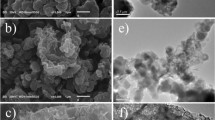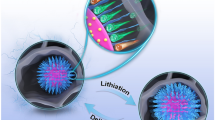Abstract
The aim was to prepare mesoporous composites of graphene oxide (GO) and titania with improved physicochemical properties for use as electrodes in electrochemical double layer capacitors (EDLCs). This was done by using a known amount of titania (5, 10, 20 and 40 wt%) to synthesise graphene oxide-titania (GOTi), reduced graphene oxide-titania (RGOTi) and nanocrystalline cellulose (NCC) reduced graphene oxide-titania (CRGTi) composites by sol–gel method. Titania positively impacted the exfoliation of GO sheets but excess amounts culminated in large titania agglomerates in the composites. The carbon-oxygen-titanium interactions, facilitated by oxygen moieties, were strongest in the GOTi composites. The reduction of GOTi, to form RGOTi, enhanced the surface area from 136.89 to 434.24 m2 g− 1 for the 5 wt% titania composites. The RGOTi composites were more defective than the GOTi ones with an ID/IG ratio of 1.13 and 0.88, respectively, at 40 wt% titania. Inclusion of NCC in the synthesis of RGOTi composites enhanced the surface areas relative to those of both GOTi and RGOTi at 10–40 wt% titania. The 5 wt% titania RGOTi composite displayed the best EDLC quality with the highest specific capacitance of 45 F g− 1 in sodium sulfate electrolyte.
















Similar content being viewed by others
References
M.V. Kiamahalleh, SHS Zein, Multiwalled carbon nanotubes based nanocomposites for supercapacitors: a review of electrode materials. NANO 7(2), 1–27 (2012)
DDL Chung, A review of exfoliated graphite. J. Mater. Sci. 51(1), 554–568 (2015). doi:10.1007/s10853-015-9284-6
T. Chen, Y. Fan, G. Wang, J. Zhang, H. Chuo, R. Yang, Rationally designed carbon fiber@NiCo2O4@polypyrrole core–shell nanowire array for high-performance supercapacitor electrodes. Nano 11(02), 1650015 (2016). doi:10.1142/s1793292016500156
J. Lee, K. Lee, S.S. Park, Environmentally friendly preparation of nanoparticle-decorated carbon nanotube or graphene hybrid structures and their potential applications. J. Mater. Sci. 51(6), 2761–2770 (2015). doi:10.1007/s10853-015-9581-0
E.T. Mombeshora, R. Simoyi, V.O. Nyamori, P.G. Ndungu, Multiwalled carbon nanotube-titania nanocomposites: understanding nano-structural parameters and functionality in dye-sensitized solar cells. S. Afr. J. Chem. 68, 153–164 (2015). doi:10.17159/0379-4350/2015/v68a22
Y. Bai, M. Du, J. Chang, J. Sun, L. Gao, Supercapacitors with high capacitance based on reduced graphene oxide/carbon nanotubes/NiO composite electrodes. J. Mater. Chem. A 2(11), 3834–3840 (2014). doi:10.1039/c3ta15004f
J. Durantini, P.P. Boix, M. Gervaldo, G.M. Morales, L. Otero, J. Bisquert, E.M. Barea, Photocurrent enhancement in dye-sensitized photovoltaic devices with titania–graphene composite electrodes. J. Electroanal. Chem. 683, 43–46 (2012). doi:10.1016/j.jelechem.2012.07.032
J. Du, X. Lai, N. Yang, J. Zhai, D. Kisailus, F. Su, D. Wang, L. Jiang, Hierarchically ordered macro mesoporous TiO2 graphene composite films: improved mass transfer, reduced charge recombination, and their enhanced photocatalytic activities. Am. Chem. Soc. Nano 5(1), 590–596 (2011)
Q. Xiang, J. Yu, M. Jaroniec, Enhanced photocatalytic H(2)-production activity of graphene-modified titania nanosheets. Nanoscale 3(9), 3670–3678 (2011). doi:10.1039/c1nr10610d
A.F. Gualdrón-Reyes, A.M. Meléndez, M.E. Niño-Gómez, V. Rodríguez-González, M.I. Carreño-Lizcano, Photoanodes modified with reduced graphene oxide to enhance photoelectrocatalytic performance of B-TiO2 under visible light. Revista de la Academia Colombiana de Ciencias Exactas, Físicas y Naturales 39(Supl.), 77 (2015). doi:10.18257/raccefyn.252
W. Geng, H. Liu, X. Yao, Enhanced photocatalytic properties of titania-graphene nanocomposites: a density functional theory study. Phys. Chem. Chem. Phys. 15(16), 6025–6033 (2013). doi:10.1039/c3cp43720e
T.N. Lambert, C.A. Chavez, B. Hernandez-Sanchez, P. Lu, N.S. Bell, A. Ambrosini, T. Friedman, T.J. Boyle, D.R. Wheeler, D.L. Huber, Synthesis and characterization of titania-graphene nanocomposites. J. Phys. Chem. C 113:19812–19823 (2009)
L.-L. Qu, N. Wang, Y.-Y. Li, D.-D. Bao, G.-H. Yang, H.-T. Li, Novel titanium dioxide–graphene–activated carbon ternary nanocomposites with enhanced photocatalytic performance in rhodamine B and tetracycline hydrochloride degradation. J. Mater. Sci. 52(13), 8311–8320 (2017). doi:10.1007/s10853-017-1047-0
V.C. Anitha, N. Hamnabard, A.N. Banerjee, G.R. Dillip, S.W. Joo, Enhanced electrochemical performance of morphology-controlled titania-reduced graphene oxide nanostructures fabricated via a combined anodization-hydrothermal process. RSC Adv. 6(15), 12571–12583 (2016). doi:10.1039/c5ra23722j
N.J. Bell, Y.H. Ng, A. Du, H. Coster, S.C. Smith, R. Amal, Understanding the Enhancement in Photoelectrochemical Properties of Photocatalytically Prepared TiO2-Reduced Graphene Oxide Composite. J. Phys. Chem. C 115(13), 6004–6009 (2011). doi:10.1021/jp1113575
O. Akhavan, E. Ghaderi, Photocatalytic reduction of graphene oxide nanosheets on TiO2 thin film for photoinactivation of bacteria in solar light irradiation. J. Phys. Chem. C 113, 20214–20220 (2009)
H. Zhang, P. Xu, G. Du, Z. Chen, K. Oh, D. Pan, Z. Jiao, A facile one-step synthesis of TiO2/graphene composites for photodegradation of methyl orange. Nano Res. 4(3), 274–283 (2010). doi:10.1007/s12274-010-0079-4
J. Sun, H. Zhang, L.H. Guo, L. Zhao, Two-dimensional interface engineering of a titania-graphene nanosheet composite for improved photocatalytic activity. ACS Appl. Mater. Interfaces 5(24), 13035–13041 (2013). doi:10.1021/am403937y
T. Rath, P.P. Kundu, Reduced graphene oxide paper based nanocomposite materials for flexible supercapacitors. RSC Adv. 5(34), 26666–26674 (2015). doi:10.1039/c5ra00563a
C.-J. Kim, W. Khan, D.-H. Kim, K.-S. Cho, S.-Y. Park, Graphene oxide/cellulose composite using NMMO monohydrate. Carbohydr. Polym. 86(2), 903–909 (2011). doi:10.1016/j.carbpol.2011.05.041
L. Valentini, M. Cardinali, E. Fortunati, L. Torre, J.M. Kenny, A novel method to prepare conductive nanocrystalline cellulose/graphene oxide composite films. Mater. Lett. 105, 4–7 (2013). doi:10.1016/j.matlet.2013.04.034
D. Han, L. Yan, W. Chen, W. Li, P.R. Bangal, Cellulose/graphite oxide composite films with improved mechanical properties over a wide range of temperature. Carbohydr. Polym. 83(2), 966–972 (2011). doi:10.1016/j.carbpol.2010.09.006
Y. Liu, H. Wang, G. Yu, Q. Yu, B. Li, X. Mu, A novel approach for the preparation of nanocrystalline cellulose by using phosphotungstic acid. Carbohydr. Polym. 110, 415–422 (2014). doi:10.1016/j.carbpol.2014.04.040
S. Montes, P.M. Carrasco, V. Ruiz, G. Cabañero, H.J. Grande, J. Labidi, I. Odriozola, Synergistic reinforcement of poly(vinyl alcohol) nanocomposites with cellulose nanocrystal-stabilized graphene. Compos. Sci. Technol. 117, 26–31 (2015). doi:10.1016/j.compscitech.2015.05.018
E.T. Mombeshora, P.G. Ndungu, V.O. Nyamori, Effect of graphite/sodium nitrate ratio and reaction time on the physicochemical properties of graphene oxide. New Carbon Mater. 32(1), 174–187 (2017)
H.S. Wahab, S.H. Ali, A.M.A. Hussein, Synthesis and characterization of graphene by Raman spectroscopy. J. Mater. Sci. Appl. 1(3), 130–135 (2015)
D. Kostiuk, M. Bodik, P. Siffalovic, M. Jergel, Y. Halahovets, M. Hodas, M. Pelletta, M. Pelach, M. Hulman, Z. Spitalsky, M. Omastova, E. Majkova, Reliable determination of the few-layer graphene oxide thickness using Raman spectroscopy. J. Raman Spectrosc. 47(4), 391–394 (2016). doi:10.1002/jrs.4843
D.C. Marcano, D.V. Kosynkin, J.M. Berlin, A. Sinitskii, Z. Sun, A. Slesarev, L.B. Alemany, W. Lu, J.M. Tour, Improved synthesis of graphene oxide. ACS Nano 4(8), 4806–4814 (2010). doi:10.1021/nn1006368
M. Xu, Q. Huang, X. Wang, R. Sun, Highly tough cellulose/graphene composite hydrogels prepared from ionic liquids. Ind. Crops Prod. 70, 56–63 (2015). doi:10.1016/j.indcrop.2015.03.004
H. Zhang, X. Lv, Y. Li, Y. Wang, J. Li, P25-Graphene composite as a high performance photocatalyst. American Chemical Society 4(1), 380–386 (2010)
S.D. Perera, R.G. Mariano, K. Vu, N. Nour, O. Seitz, Y. Chabal, K.J. Balkus, Hydrothermal synthesis of graphene-TiO2 nanotube composites with enhanced photocatalytic activity. ACS Catal. 2(6), 949–956 (2012). doi:10.1021/cs200621c
W.-S. Hung, C.-H. Tsou, M. De Guzman, Q.-F. An, Y.-L. Liu, Y.-M. Zhang, C.-C. Hu, K.-R. Lee, J.-Y. Lai, Cross-linking with diamine monomers to prepare composite graphene oxide-framework membranes with varying d-Spacing. Chem. Mater. 26(9), 2983–2990 (2014). doi:10.1021/cm5007873
A.A. King, B.R. Davies, N. Noorbehesht, P. Newman, T.L. Church, A.T. Harris, J.M. Razal, A.I. Minett, A new Raman metric for the characterisation of graphene oxide and its derivatives. Sci. Rep. 6, 19491 (2016). doi:10.1038/srep19491
R. Atchudan, A. Pandurangan, J. Joo, Synthesis of multilayer graphene balls on mesoporous Co-MCM-41 molecular sieves by chemical vapour deposition method. Microporous Mesoporous Mater. 175, 161–169 (2013)
L.-L. Tan, W.-J. Ong, S.-P. Chai, A.R. Mohamed, Reduced graphene oxide-TiO2 nanocomposite as a promising visible-light-active photocatalyst for the conversion of carbon dioxide. Nanoscale Res. Lett. 8(465), 1–9 (2013)
D.R. Dreyer, S. Park, C.W. Bielawski, R.S. Ruoff, The chemistry of graphene oxide. Chem. Soc. Rev. 39(1), 228–240 (2010). doi:10.1039/b917103g
K. Sing, The use of nitrogen adsorption for the characterisation of porous materials. Colloids Surf. A 187–188, 3–9 (2001)
Y.H. Tan, J.A. Davis, K. Fujikawa, N.V. Ganesh, A.V. Demchenko, K.J. Stine, Surface area and pore size characteristics of nanoporous gold subjected to thermal, mechanical, or surface modification studied using gas adsorption isotherms, cyclic voltammetry, thermogravimetric analysis, and scanning electron microscopy. J. Mater. Chem. 22(14), 6733–6745 (2012). doi:10.1039/C2JM16633J
E.T. Mombeshora, V.O. Nyamori, A review on the use of carbon nanostructured materials in electrochemical capacitors. Int. J. Energy Res. 39(15), 1955–1980 (2015). doi:10.1002/er.3423
E.P. Barrett, E.G. Joyner, P.P. Halenda, The determination of pore volume and area distributions in porous substances. I. Computations from nitrogen isotherms. Vol. Area Distrib. Porous Subst. 73, 373–380 (1951)
D. He, Y. Li, J. Wang, Y. Yang, Q. An, Tunable nanostructure of tio2/reduced graphene oxide composite for high photocatalysis. Appl. Microsc. 46(1), 37–44 (2016). doi:10.9729/am.2016.46.1.37
X. Luan, M.T. Gutierrez Wing, Y. Wang, Enhanced photocatalytic activity of graphene oxide/titania nanosheets composites for methylene blue degradation. Mater. Sci. Semicond. Process. 30, 592–598 (2015). doi:10.1016/j.mssp.2014.10.032
E.T. Mombeshora, P.G. Ndungu, ALL Jarvis, V.O. Nyamori, Oxygen-modified multiwalled carbon nanotubes: physicochemical properties and capacitor functionality. Int. J. Energy Res. (2017). doi:10.1002/er.3702
Y. Wang, M. Liu, Y. Liu, J. Luo, X. Lu, J. Sun, A novel mica-titania@graphene core-shell structured antistatic composite pearlescent pigment. Dyes Pigm. 136, 197–204 (2017)
J. Wang, S.A. Kondrat, Y. Wang, G.L. Brett, C. Giles, J.K. Bartley, L. Lu, Q. Liu, C.J. Kiely, G.J. Hutchings, Au–Pd nanoparticles dispersed on composite titania/graphene oxide-supports as a highly active oxidation catalyst. ACS Catal. 5(6), 3575–3587 (2015). doi:10.1021/acscatal.5b00480
K. Mugadza, V.O. Nyamori, G.T. Mola, R.H. Simoyi, P.G. Ndungu, Low temperature synthesis of multiwalled carbon nanotubes and incorporation into an organic solar cell. J. Exp. Nanosci. (2017). doi:10.1080/17458080.2017.1357842
V.B. Mohan, R. Brown, K. Jayaraman, D. Bhattacharyya, Characterisation of reduced graphene oxide: Effects of reduction variables on electrical conductivity. Mater. Sci. Eng 193, 49–60 (2015). doi:10.1016/j.mseb.2014.11.002
R. Beams, L. Gustavo Cancado, L. Novotny, Raman characterization of defects and dopants in graphene. J. Phys. Condens. Matter 27(8), 083002 (2015). doi:10.1088/0953-8984/27/8/083002
D. Maruthamani, D. Divakar, M. Harshavardhan, M. Kumaravel, Evaluation of bactericidal activity of reduced graphene oxide supported titania nanoparticles under visible light irradiation. J. Chem. Pharm. Res. 8(1), 236–244 (2016)
P. Georgios, S.M. Wolfgang, X-ray photoelectron spectroscopy of anatase-TiO2 coated carbon nanotubes. Solid State Phenomena 162, 163–177 (2010)
J.-Y. Ruzicka, F.A. Bakar, L. Thomsen, B.C. Cowie, C. McNicoll, T. Kemmitt, H.E.A. Brand, B. Ingham, G.G. Anderssonf, V.B. Golovko, XPS and NEXAFS study of fluorine modified TiO2 nano-ovoids reveals dependence of Ti3+ surface population on the modifying agent. RSC Adv. 4, 20649–20658 (2014)
Y.-Y. Dong, S. Liu, Y.-J. Liu, L.-Y. Meng, M.-G. Ma, Ag@Fe3O4@cellulose nanocrystals nanocomposites: microwave-assisted hydrothermal synthesis, antimicrobial properties, and good adsorption of dye solution. J. Mater. Sci. 52(13), 8219–8230 (2017). doi:10.1007/s10853-017-1038-1
J.-G. Wang, Y. Yang, Z.-H. Huang, F. Kang, Synthesis and electrochemical performance of MnO2/CNTs–embedded carbon nanofibers nanocomposites for supercapacitors. Electrochim. Acta 75, 213–219 (2012). doi:10.1016/j.electacta.2012.04.088
Z. Zhou, X.-F. Wu, High-performance porous electrodes for pseudosupercapacitors based on graphene-beaded carbon nanofibers surface-coated with nanostructured conducting polymers. J. Power Sources 262, 44–49 (2014)
Y.S. Yun, S. Lee, N.R. Kim, M. Kang, C. Leal, K.-Y. Park, K. Kang, H.-J. Jin, High and rapid alkali cation storage in ultramicroporous carbonaceous materials. J. Power Sources 313, 142–151 (2016). doi:10.1016/j.jpowsour.2016.02.068
Acknowledgements
The authors would like to thank Mr Vashen Moodley and Prof Werner van Zyl for their generous donation of NCC used for the synthesis of CRGTi composites. We thank Prof Martincigh for proofreading the manuscript. The authors are also grateful to the University of KwaZulu-Natal (UKZN) and UKZN Nanotechnology Platform for the facilities used in this work and a partial study bursary for Mr ETM, respectively.
Author information
Authors and Affiliations
Corresponding author
Ethics declarations
Conflict of interest
The authors declare that they have no conflict of interest.
Electronic supplementary material
Below is the link to the electronic supplementary material.
Rights and permissions
About this article
Cite this article
Mombeshora, E.T., Nyamori, V.O. Physicochemical characterisation of graphene oxide and reduced graphene oxide composites for electrochemical capacitors. J Mater Sci: Mater Electron 28, 18715–18734 (2017). https://doi.org/10.1007/s10854-017-7821-6
Received:
Accepted:
Published:
Issue Date:
DOI: https://doi.org/10.1007/s10854-017-7821-6




